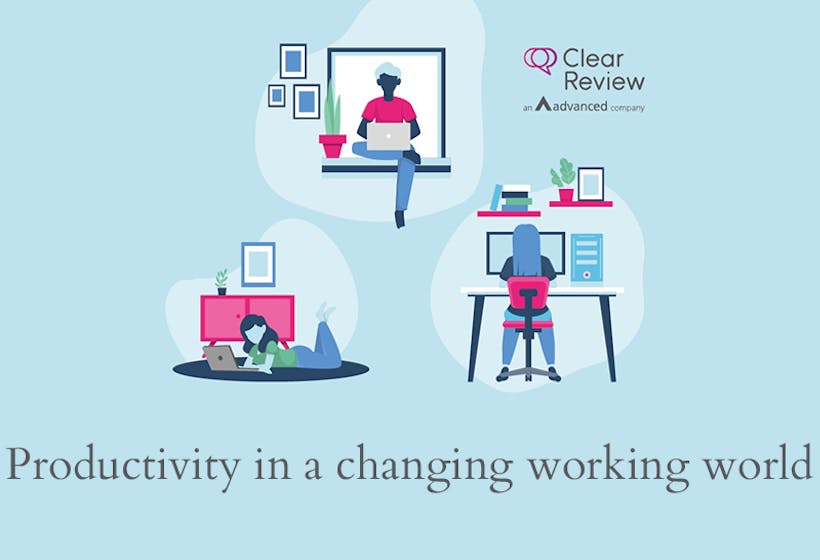
Hybrid working is the subject on everyone’s lips at the moment. How will it work? What’s the most effective office to remote split? Will it be permanent? And, of course, will staff be productive when splitting their time between locations?
So what is hybrid working?
Hybrid working is a way of combining office work and remote working to better fit the needs of the organisation and its staff. It can look different depending on the organisation, some may choose to have set rules such as ‘all staff come into the office 3 days a week’, whilst others may let staff choose which location they work in on a day to day basis. How your hybrid system will look should be considered carefully, so you ensure it works as well as possible for your staff and your organisation.
Staff productivity is key for an organisation to succeed, so if staff are distracted, unsettled or stressed at work, this can have a huge knock on effect. But how can you combat this? How do you ensure your staff are productive in a hybrid working environment?
Whilst we don’t have some magic formula for productivity, we do have some useful hints and tips that can help your organisation boost productivity during hybrid work.
Have regular check-ins with your staff
Communication is always important in an organisation, whether working fully in the office, remotely, or a bit of both. Clear and regular conversations are key to ensuring that everyone is aligned in their goals and performing as they should be. By managers and staff having check-ins at least once a month, your organisations can keep a closer eye on its people, so if anyone is struggling, steps can be taken to help.
Listen to what they’re saying
If staff are struggling / have any blockers, be sure managers and HR are listening to them. It’s no use having a monthly check-in for staff to talk to their managers, if nothing comes of it when they raise issues. For some, hybrid working will be a struggle for many different reasons.
Some people will want to work from home full time, others may be struggling with a less than ideal home working set up, and then there will be those who don’t like splitting their time between two places.
Make hybrid rules as clear as possible
Whatever you decide to do around hybrid working, be sure there is no ambiguity around your hybrid working rules. All your staff need to know what is expected of them, and why you have made these decisions for your organisation. This way there will be no room for misunderstandings within teams.
Ensure they have everything they need
If your team is split between two locations, ensure they have everything they need both in the office and wherever they are working remotely. A lot of staff will have moved pieces of equipment from offices to their home. Practically speaking, they won’t be able to move large pieces of equipment (such as chairs, monitors etc.) back and forth every week.
Somebody who is uncomfortable in their set up is unlikely to be as productive as possible, so if your organisation is implementing hybrid working, you’ll need to provide your staff with everything they need to work comfortably at both working locations.
Consider staff members different home set ups
Whilst you may be hoping you can find a one size fits all solution for your hybrid working model, this may not be possible. Whilst many people enjoy working from their homes, and find it a productive place to work, others don’t feel this way. Consider parents who have children at home during the working day, or younger workers who have house mates, or are working from their bedrooms.
If someone is telling you their remote set up doesn’t allow for a productive work set up, listen to them, and if possible, allow them to be in the office as often as they need.
Think about tasks, rather than days
Rather than asking staff to come into the office, for example, every Monday and Thursday, or a minimum of 3 days a week, instead you could ask them to be in the environment that best suits the task they are carrying out.
If staff have meetings that would better be performed face to face, or they’re working on a project that could be benefitted by co-worker input, then it makes sense for them to be in the office for these tasks. But if they are writing up a report by themselves, or making a call that requires a quieter space, working from home may suit this better.
Therefore staff should review the tasks they have on during the week and ask themselves based on this, would this day be more suited to office working, or remote working?
In conclusion, to drive productivity in a hybrid working environment, managers and HR should be aware of their staff’s needs, listen to their issues, and do all they can to support their team. In 2019 research by Oxford University determined that staff are 13% more productive when they are happy, so making sure staff are happy in their working environment is key to productivity!
Follow our campaign for more information on driving Performance Management in a changing working world.
Want to see how Clear Review can help you?
If you want to see all the benefits of Clear Review, book a free demo.
